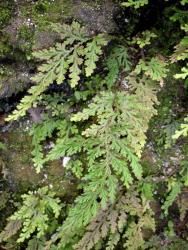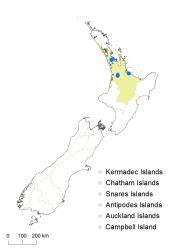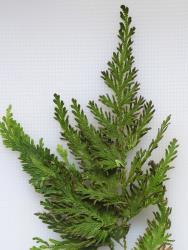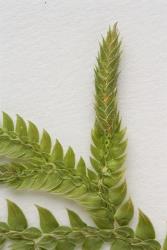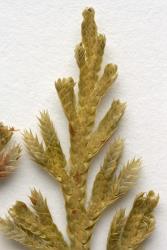Terrestrial plants. Basal stems very short-creeping, bearing erect, unbranched aerial stems that give rise to a frond-like branch-system of finite growth; "fronds" 75–300 mm long; unbranched stems 10–155 mm long; branching portion of "fronds" 65–210 mm long, 20–120 mm wide; longest lateral branches 15–110 mm long. Roots arising only at the base of the main aerial stems. Leaves widely spaced on the unbranched portion of aerial stems; those on the branching portion 1.5–3.0 mm long, 0.9–1.8 mm wide, ovate, acuminate, minutely toothed on margins, cordate at base. Leaves on ultimate aerial branches densely imbricate, minutely toothed on margins, rounded at base, of two sizes, both decreasing in size towards stem apices; those in the two lateral rows larger, 1.2–2.2 mm long, 0.6–1.4 mm wide, spreading, broadly ovate, apices acute; those in the two upper rows smaller, 1–1.7 mm long, 0.5–0.8 mm wide, closely appressed to stem, ovate, acuminate to attenuate. Strobili terminal on ultimate branches, sessile, 5–9 mm long, 1.7–2.0 mm diameter, sharply 4-angled in cross-section. Sporophylls similar to leaves of upper rows but slightly smaller, 1.6–1.8 mm long, arranged in 4 ranks, monomorphic. Megaspores not seen. Microspores orange, baculate/clavate.
In New Zealand, Selaginella moellendorffii is easily recognised by its erect, aerial, frond-like branching systems with roots confined to the base. It is quite distinct from the prostrate or suberect, irregularly branching stems of S. kraussiana and S. martensii. The microspores of S. moellendorfii are also very distinctive, with baculate/clavate projections (Large & Braggins 1991, figs 49–57).
North Island: Auckland, Volcanic Plateau.
Altitudinal range: 20–65 m.
Collected from a few sites in Auckland, Hamilton, and Tauranga.
Occurs naturally in China, Japan, Taiwan, Vietnam, and Philippines (Zhang et al. 2013).
Selaginella moellendorffii is a terrestrial species that grows on sunny banks and on river banks and in damp, shaded sites, probably as an escape from cultivation.
Brownsey (1981, p.11). Voucher WELT P010222, 1978.



